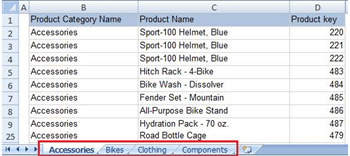Winner of Best BI Software for SQL. Get the Most out of Your Data. Watch the Free Tableau Video Demo! Move Forward With Confidence. Connecting With The Data Community.
Leverage Existing SQL Skills In NoSQL With N1QL JSON Queries. Join over 100students who have taken the course. When to use a join in SQL? What are different types of join in SQL? How do you combine two tables in SQL?
JOIN 4: Outer join between DT and SalesOrderHeader resulting in a derived table, DT 4. As shown in the Venn diagram, we need to matched rows of all tables. For this reason, we will combine all tables with an inner join clause. The difference is outer join keeps nullable values and inner join filters it out. So I’ll show you examples of joining tables in MySQL for both types of join. You can simply add another join like this: SELECT dashboard_data.

How to use multiple LEFT JOINs in SQL? INNER JOIN images ON dashboard_messages. The new table contains all possible combinations of rows from the original tables. SQL provides several types of joins such as inner join , outer joins ( left outer join or left join , right outer join or right join , and full outer join ) and self join. There are six types of SQL Joins , and they are: Inner Join : Also called Join.
It returns the rows present in both the Left table and right table only if there is a match. Otherwise, it returns zero records. Full Outer Join : Also called as Full Join. It returns all the rows present in both the Left table and the right table. A JOIN clause is used to combine rows from two or more tables, based on a related column between them.
There are common identifiers in a couple of them between the four, but not across all four. The Using clause is used to shorten the specified code. In real world scenarios user needs to write huge complex sql queries. In those cases user needs to shorten the code and with ‘Using’ clause user can shorten the code. Each query may comprise zero, one, or more joins.
A multiple join is a use of more than one join in a single query. The joins used may be all of the same type, or their types can differ. We’ll begin our discussion by showing an example query that uses two joins of the same type. Take a look at the query below.

Summary: in this tutorial, we will introduce you another kind of joins called SQL LEFT JOIN that allows you to retrieve data from multiple tables. Introduction to SQL LEFT JOIN clause. In the previous tutorial, you learned about the inner join that returns rows if there is, at least, one row in both tables that matches the join condition.
The inner join clause eliminates the rows that do not match with a row of the other table. If no matching rows found in the right table, NULL are used. Normally, filtering is processed in the WHERE clause once the two tables have already been joined. For example, you only want to create matches between the tables under certain circumstances. The SQL LEFT JOIN (specified with the keywords LEFT JOIN and ON) joins two tables and fetches all matching rows of two tables for which the SQL -expression is true, plus rows from the frist table that do not match any row in the second table.
Think of two tables that are beside each other, a table on the left and a table on the right. The LEFT OUTER JOIN selects all rows in the right table that match the relational comparison criteria, and also selects all rows from the left table, even if no match exists in the right table. By using joins, you can retrieve data from two or more tables based on logical relationships between the tables. To make multiple joins work in MS Access database, we need to enclose join query with parentheses.
To join Faculty to the Division, Country, and Nationality tables, the fields DivisionI CountryID and NationalityID would need to be foreign keys in the Faculty table.
Nincsenek megjegyzések:
Megjegyzés küldése
Megjegyzés: Megjegyzéseket csak a blog tagjai írhatnak a blogba.